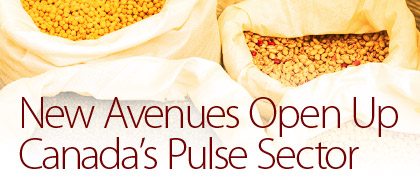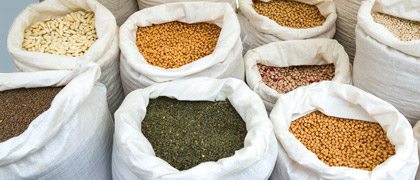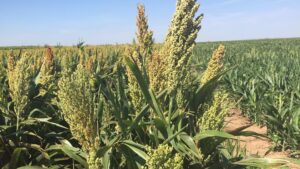
Canada’s pulse industry has progessed by leaps and bounds during the past decade. That momentum is expected to continue thanks to ongoing research efforts and new areas of investment for the pulse sector.
During the past 20 years, Canada’s pulse industry has grown from producing less than one million tonnes of pulses in 1990 to more than six million tonnes in 2013. This momentum and continued farmer adoption has many in the industry excited.
Field peas, lentils, dry beans and chickpeas are the primary pulses grown in Canada, listed respective to acreage. Other pulses include faba bean, mung bean and lupin. Also, Canada is the largest global exporter of peas and lentils, with a combined production reaching just over 5.5 million tonnes in 2013.
While many factors influence production, Carl Potts, executive director with Saskatchewan Pulse Growers, says research and development in genomics and traits helps Canada maintain its global competitiveness. “In the 1980s, growers voted in favour of a one per cent levy on the sale of pulse crops, which helps maintain these far-reaching research and development efforts in Canada,” Potts says.
SPG also works closely with other pulse-producing provinces such as Manitoba, Alberta and Ontario to streamline research programs and further collaborative efforts. “Current projects include sequencing of genomes in peas and lentils, creating improved tools for breeders to help speed up the breeding process, and improving traits and tolerances in new varieties,” Potts says.
Bringing a new variety to market can take up to a decade, and Potts is particularly excited about the current lentil and pea genome sequencing projects that are being conducted to further trait development.
“SPG has invested $3 million into pea and lentil genome sequencing projects, helping Canada to take the leadership position globally, which is being led by University of Saskatchewan scientists,” Potts says. “For the pea genome sequencing project, we are part of a international consortium working together with scientists around the globe.”
While great progress has been made, obstacles still exist. Maintaining competitive farm gate levels compared to other viable crops can, at times, be a burden. “Producers need to not only achieve attractive prices, but also receive favourable returns on their crop investments,” Potts says. “This is why continued investment in new varietal research and development is key. Higher quality pulse varieties and increased yields all contribute to a farmer’s bottom line. That’s why it’s so important to continue to invest in market development, breeding and agronomy programs.”
Parthiba Balasubramanian, a dry bean breeder with Agriculture and Agri-Food Canada based in Lethbridge, Alta., agrees that continued research is vital to overcoming market challenges. “It’s expensive to plant a pulse crop and, in particular, a dry bean crop,” he says. “The seeds are large and the crop often requires additional inputs throughout the growing season. Breeders continue to bring out the best in genetics so that producers can achieve higher yields.”
Continued investments in research and development keep Canadian pulses competitive.
Varietal Development
Balasubramanian and his colleagues are working on developing a dry bean variety that has the quality of both a late and early maturing variety for optimal yield. “Our goal is to bring a new cultivar to market that contains optimal yield, yet will withstand disease pressures and Mother Nature.”
In July, AAFC Lethbridge released a new black bean aimed for irrigated production, which received regulatory approval in February. Seed multiplication of the new variety is underway and Balasubramanian is excited to finally see it come to market.
“We not only tested it in the field, but also tested it for cooking and canning qualities,” Balasubramanian explains. “We needed to ensure that it would provide good yield, but since pulse crops are for the food industry, we also needed to ensure it cooked well and could be canned.”
According to Balasubramanian, producers realize that incorporating a pulse crop into their rotations is a viable and productive option for their farm business. “Using a pulse crop in a farm’s rotation practice can help to loosen soil due to its root structure and can also help to break disease cycles in other crops, such as cereals,” he says.
New Market Avenues
Despite planting less than half a million acres across the country, Canada is the world’s third largest exporter of dry beans. Canada is a dominant player on the global scene because of its robust export market and high-quality seed supply. “High yield combined with good seed quality allows Canadian producers to benefit in this premium market,” Balasubramanian says. “While yield and quality are important, so are size, shape and colour.”
Additionally, Canada’s research and development efforts are stronger than ever. Both Potts and Balasubramanian agree that there’s a plethora of new market avenues to explore that show the potential for additional revenue streams for the Canadian pulse market.
“There are new areas in value-added processing of pulse crops,” Potts says. “The food industry is looking at pea flour to incorporate into bread and pasta products, which is a new and viable marketing area.”
Potts adds that pulse crops are also gluten-free, high in protein and fibre content and have relatively low glycemic levels, offering another option for people with dietary restrictions. “There is increasing interest by those in the food industry in some of the alternative options that pulse crops can offer,” Potts says.
Balasubramanian agrees that new options for the end users will only be more favourable for producers who grow pulse crops. “Continued demand around the world, along with more product opportunities for pulses, such as in spaghetti and tortilla products — which are already being developed — will help maintain and ensure future growth for the industry as a whole.”
Shannon Schindle













